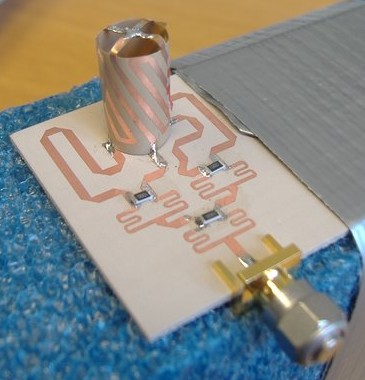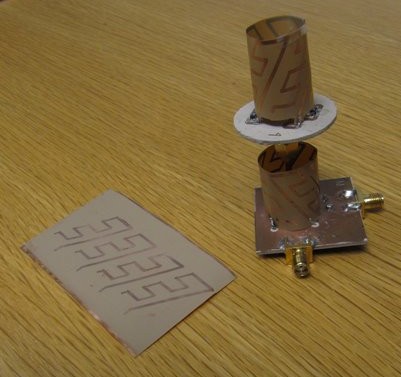
The Centre for Communication Systems Research (CCSR), where Dr Tim Brown has worked for several years, has treasured IPR claims on the versions of the widely used quadrifilar helix antenna (QHA) it has produced. One major patent concerns the fact that the QHA can have adapted weights in order to enable the antenna to electronically steer the direction it is able to receive or transmit without having to physically orientate the antenna. The antenna in this case is then deemed as an intelligent antenna known as an intelligent quadrifilar helix antenna (IQHA). The other major IPR concerns the minaturisation of the antenna with more than one helix element, thus being a multi-filar minature antenna, where CCSR has produced several examples, some of which fall under Dr Brown's supervision.

A folded quadrifilar helix antenna for use on a small mobile termainal such sa for mobile broadcasting, with over 50% reduction from the conventional sized quadrifilar helix.
Another highly useful aspect of the quadrifilar, is the ease of manufacture since through the use of flexible thin printed circuit board materials, it is possible to produce a printed version of the antenna, which can be quickly rolled up and produced into a fully constructed antenna, thus giving it comparable advantages to other printed antennas. The other strengths of the antenna are its ability to produce high quality circular polarisation patterns, which is desirable for land mobile satellite communications but also a number of other applications where it is being deployed. The further benefit it offers as an IQHA is its ability to be switched between two modes, as a directional circular polarised antenna, while also it can become an omni-directional linear polarised antenna. Such a design is highly useful for mobile systems switching between terrestrial and satellite communications.

An illustration of using a printed dual polar quadrifilar helix for easy implementation. This design would be suitable for vehicular applications as one example.
Enquiries are invited with regards to research regarding design of small quadrifilar helix antennas, custom built quadrifilar antennas for a specific application as well as field trial tests for quadrifilar antennas.
Publications produced by Dr Brown on QHA antenna solutions include the following:
Contribution to Chapter 4, "Assessment and Modelling of Terminal Antenna Systems", published in "Pervasive Mobile and Ambient Wireless Communications", COST Action 2100 Report, Springer, 2012. Link
M F Mansor, T W C Brown, B G Evans, "Satellite MIMO Measurement with Co-located Quadrifilar Helix Antennas at the Receiver Terminal", IEEE Antennas and Wireless Propgataion Letters, vol. 9, pp712-715, 2010.
M F B Mansor, T W C Brown, B G Evans, "A Dual Circularly Polarised Contrawound Quadrifilar Helix Antenna for Land Mobile Satellite MIMO Terminal", European Conference of Antennas and Propagation, 2009.
T W C Brown, "Enhancement of the Intelligent Quadrifilar Helix using MIMO Antenna Selection at a WLAN Access Point", European Conference of Antennas and Propagation, 2009.
T W C Brown, K C D Chew, S R Saunders, "Analysis of the Diversity Potential of an Intelligent Quadrifilar Helix Antenna", IEE 12th International Conference of Antennas and Propagation - ICAP 2003, no. 491 vol 1, pp194-197, Held at the University of Exeter, UK, 31st March - 3rd April 2003.
Click here for contact details.
Tim Brown
February 2012